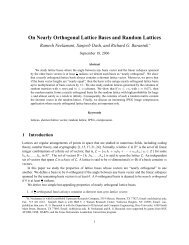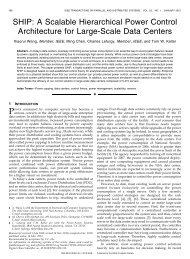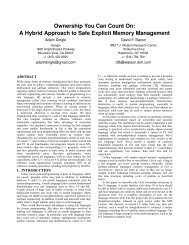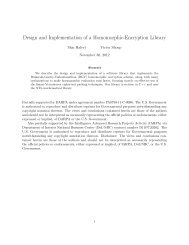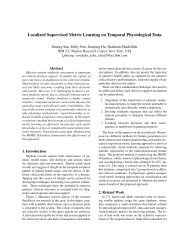SSS: A Hybrid Architecture Applied to Robot Navigation - CiteSeerX
SSS: A Hybrid Architecture Applied to Robot Navigation - CiteSeerX
SSS: A Hybrid Architecture Applied to Robot Navigation - CiteSeerX
You also want an ePaper? Increase the reach of your titles
YUMPU automatically turns print PDFs into web optimized ePapers that Google loves.
perfectly straight in the symbolic map. However, when therobot is instructed <strong>to</strong> follow the same path a second timeand update the map, the changes are minimal.large displacements. However, the local details arequalitatively correct (some of the angularity is due <strong>to</strong> thetime lag between successive position readings). Ondifferent runs we started the robot in slightly differentdirections. We also altered the positions of variousobstacles along the path and changed the states of some ofthe doors on the corridor. This lead <strong>to</strong> slightly differentforms for each of the runs. Despite these variations ininitial heading and the configuration of the environment,the symbolic system was able <strong>to</strong> successfully navigate therobot <strong>to</strong> its goal in all 5 runs.Figure 5 - These traces illustrate the odometrically perceivedpath of the robot on 5 consecutive runs along the same path.Notice that the wiggles along each segment are different sinceobstacles were moved and doors were altered between runs. Tothe symbolic system, however, all runs seemed identical.Figure 4 - Geometric constraints of the environment allowthe robot <strong>to</strong> build maps with loops despite poor absoluteodometry. The <strong>to</strong>p picture shows the path the robot thought it<strong>to</strong>ok. The hair-like projections indicate openings it sensed.The lower picture shows the map the robot built during thisexploration.The second experiment shows that the subsumptionsystem is sufficiently competent at local navigation <strong>to</strong>allow the use of a coarse geometric map. In thisexperiment we had the symbolic system plan a path (fromnode 10 <strong>to</strong> node 5) using the map it generated in the firstpart. We then <strong>to</strong>ld it <strong>to</strong> configure the two lower layers ofthe architecture <strong>to</strong> follow this path. The result of fiveconsecutive runs is shown in figure 5. The displayed pathsare based on the robot's odometry and hence do notaccurately reflect the robot's true position in space over4: DiscussionThe <strong>SSS</strong> architecture is related <strong>to</strong> a number of recentprojects in robot control architectures. The greatest degreeof similarity is with the ATLANTIS system developed atJPL [11, 9]. In this system there is a subsumption-styleÒcontrol" layer, an operating system-like Òsequencing"layer, and a model-building Òdeliberative" layer. As in ournavigation scheme, this system delegates the task offollowing a particular path segment control <strong>to</strong> a behaviorbasedsystem while using a rough <strong>to</strong>pological map <strong>to</strong>specify the turns between segments. A mobile robotdeveloped at Bell labs [15] also uses this same taskdecomposition as does the AuRA system [1] fromUMASS Amherst.However, in ATLANTIS (and in RAPs [8], itsintellectual predecessor) each of the behaviors in the




